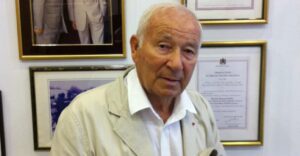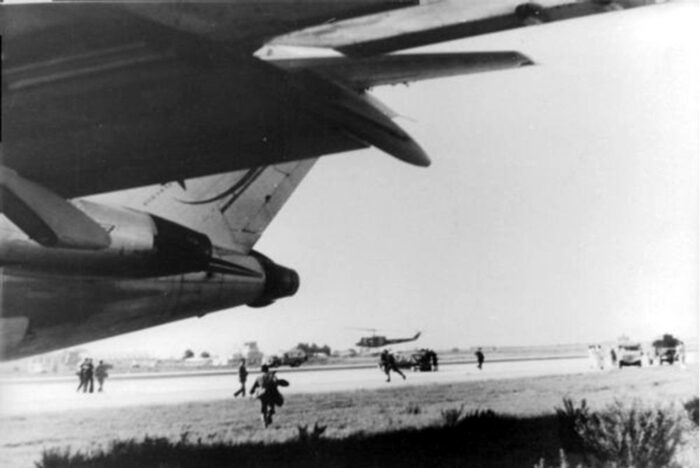Aboard the royal Boeing

The king had come with his family to French territory in July 1972. He owned the Château de Betz in the Oise region, where he enjoyed resting. The property was magnificent, tranquil, and vast. The return to Morocco was initially scheduled for August 14. However, Hassan II may have learned through American or Israeli intelligence services that an assassination plot was being planned. As a result, he delayed the departure of his Royal Air Maroc Boeing 727 by two days at the last minute.
It’s worth noting that the engines of the Boeing 727 were not mounted under the wings but positioned at the rear of the aircraft—one on each side of the central fin and one in the middle. The king was seated in an armchair at the front of the plane. Just behind him, I was traveling alongside Prince Moulay Abdellah, Colonel Ahmed Dlimi, and Mohamed Mediouri. There were about fifteen of us on board, including the king’s doctors, ministers, advisors, security agents, and Hassan II’s private secretary, Abdelfattah Frej.
When we reached the airspace above Tangier, I asked the prince if it had been arranged for an honorary escort of fighter jets to accompany the royal plane back to Morocco. Since he wasn’t aware of any such arrangement, he leaned toward his elder brother to inquire. I saw worry spread across the king’s face: no such escort had been planned. Yet I had twice seen four F-5 fighter jets suddenly zip past our Boeing.
I had enough time to observe that these jets were entirely painted in khaki and bore neither the royal insignia nor identification numbers. I immediately suspected a Libyan attack, as relations between Hassan II and Gaddafi were strained. I barely had time to tell the king and the passengers to fasten their seat belts before a deafening explosion rocked the plane.
« I took the prince’s hand (Moulay Abdellah) and told him, ‘I promise you, we’re going to make it through this’ »
One of the fighter jets fired multiple rounds to destroy the central engine. The intent was to support the narrative of an engine explosion that could steer the investigation toward a technical accident or a bomb attack, rather than targeting the cockpit directly. By some miracle, the pilot missed the target, but the plane was still hit, leaving several holes in the rear fuselage. A Moroccan inspector was killed instantly, struck in the chest by the bullets. I was riddled with shrapnel in my arm and legs, as were Prince Moulay Abdellah and Abdelfattah Frej. The sirens blared, and the oxygen masks dropped.
I took the prince’s hand and said to him, “I promise you, we’re going to make it through this.” The king, seated in front of us, didn’t move. He didn’t shout. He remained incredibly composed. He closed his eyes and began to pray. Prince Moulay Abdellah took his brother’s hand, and the four of us, along with Mediouri, held on to one another.
Kabbaj’s control, Hassan II’s inspiration
Chaos reigned inside the plane. The noise was deafening. Some dignitaries crawled down the aisle on all fours, others tried to reach the cargo hold through a hatch, and a few, having completely lost their senses, attempted to open the door to leap into the air! The quick thinking and composure of the pilot, Commander Kabbaj, a master of aviation, saved us.

From the first impact, the pilot dove sharply. In just a few seconds, we dropped from 10,000 meters to 2,000 meters in altitude. The F-5 jets continued firing, eventually damaging both side engines. We flew for over ten minutes using only the central engine. It’s a miracle that the damaged engines didn’t explode. It’s a miracle that the pilot managed to keep the Boeing balanced and continue the flight. Due to the depressurization in the cockpit, blood was spurting from my thigh in a strange little red geyser…
“Hassan II ordered in Arabic, ‘Tell the radio that I am dead! Announce my death!’”
I leaned toward the king amidst the deafening noise and chaos. He looked at me strangely, and we understood each other instantly. He ordered in Arabic, “Tell the radio that I am dead! Announce my death!” The pilot transmitted the message. Deceived, the conspirators believed they had succeeded. The F-5 jets withdrew. The control tower asked if we could make it to Rabat-Salé airport. A few days later, American experts from Boeing who came to examine the plane declared that we didn’t stand a one-in-a-million chance of reaching our destination safely. Yet, we made it.
I believe we owed our survival to the pilot’s exceptional skill and the king’s prayer! This incredible stroke of luck further elevated Hassan II’s standing among the people, who saw him as blessed by Allah. The baraka (divine blessing) of the Commander of the Faithful became a symbol of heavenly favor.
Oufkir wanted to bomb the royal palace…
Part of the international airport of Rabat-Salé is designated for the air force, and it’s from this base that the royal helicopter and plane take off and land. The pilot, demonstrating incredible composure, managed to make an emergency landing. We veered off the runway, and the plane came to a stop in the grass, tearing up the earth.
Through the windows, we saw a government delegation with mournful expressions, the royal guard in position to pay final respects to the king’s body, and General Oufkir—the mastermind of the conspiracy—present to confirm the king’s death. The door opened, and those gathered on the tarmac witnessed Colonel Dlimi, Mohamed Mediouri, and myself, Raymond Sasia, emerge with weapons drawn.
To the shock of everyone present and the utter dismay of the conspirators, Hassan II stepped out behind us, unharmed. General Oufkir rushed forward, kissed the king’s hand, and escorted him to the honor guard. Limping, I followed the king.
Inside the airport lounges, the ministers came to greet him. I cleared away those who were intrusive and, in a firm voice, announced, “His Majesty has just escaped an assassination attempt. He is unharmed but wishes to freshen up. Please lead the way in the procession. Return to your vehicles and be prepared to head toward the royal palace.”
The lounge emptied. I said to Oufkir, “Take the lead. When the king gets into his car, I’ll notify you for the procession’s departure, which you will lead.” I directed the king to the restroom so he could freshen up after all the emotions of the ordeal. Mediouri and I positioned ourselves at the entrance of the restroom. Once everyone had left, I gave the signal to Oufkir via walkie-talkie.
At the front of the convoy, Oufkir was convinced that the king had entered his car. In reality, it was the king’s brother who got into the black armored Mercedes 600, surrounded by the honor guard. In the confusion, the few witnesses didn’t notice the switch. At that moment, Oufkir gave the conspirators the order to activate phase B of the assassination plot.
One of the F-5 jets returned, spotted the convoy on the road, and opened fire to finish the job. The attack left eight dead and around fifty wounded. Meanwhile, I remained hidden inside the airport with Mediouri and the king.
We discreetly exited through a door at the back of the building. Nearby, there was a parking lot where airport employees parked their cars. There, we came across a kind man smoking a cigarette next to his small car. He was stunned to see a Frenchman, covered in blood, walking toward him with a weapon in hand.
When he recognized the king, he was overwhelmed with joy and honored to greet him. He kissed the king’s hands and feet. Hassan II asked if he would lend his car. For this humble Moroccan, it was the greatest day of his life. He handed over the keys. The king took the wheel, and we left, taking backroads until we reached Skhirat. As we exited the airport, we rejoined the royal security cars, which escorted us. Realizing he had been outmaneuvered, Oufkir considered bombing the royal palace. But the king wasn’t in Rabat. The coup had failed.
Edited in English by Eric Nielson




